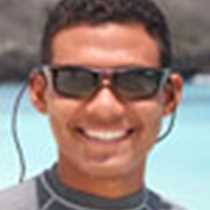The National Geographic Islander continued its schedule and took us again to the biggest island’s belly, a place called Urbina Bay. Because of the activeness of the Galapagos’ volcanoes you can find many different geological features here, including some that are very unusual. Around the 1950’s gases and pressure deep in the magma chamber pushed against the land, and five square kilometers were uplifted about fifteen feet. With all the land mass brought out of its environment several marine species died, including some of the biggest brain coral heads found in the islands. Then in later years other types of species which were not marine have been able to colonize it like land iguanas and giant tortoises. Most of our guests took the opportunity to hike on this fantastic ever-changing landscape and later took a quick swim to refresh just before coming to the ship for a well-deserved lunch.
During the afternoon we moved to one of the very few places Charles Darwin was able to set foot. This place was also used by other ships when whalers were in search of some of these cetaceans. And it is the perfect explanation to why there is graffiti all over the bay of Tagus Cove. At the beginning it was carved because the rock here is just compacted ash, but later other boats decided to use paint to leave a mark that they were here.
Options could be picked here, such as snorkeling with sea turtles, more Galapagos penguins, and cormorants. Or some guests went for the kayaking option to paddle along the shoreline of the bay to see the dramatic geological formations and the last of the flightless birds. And the last option was a hike to the summit of one of the tuff cones in Tagus, to see what Darwin himself saw – a gorgeous lagoon that now bears his name and the lava flows of the nearby volcano that is also named after him.
That was our last experience for today on Isabela island, a place full of activities, varied landscapes, and wildlife.







